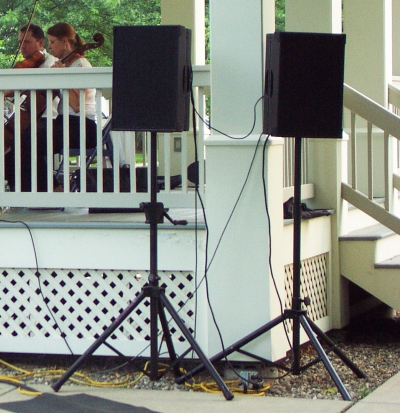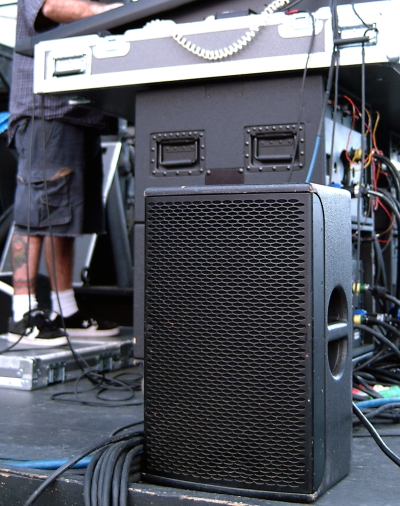
Side fill stage monitors. In larger applications it’s not uncommon to deploy additional loudspeakers on each side of the stage, pointing inward, to further enhance monitoring. Some productions even fly compact line arrays for this purpose.
On smaller stages, we often opt for a single box over a single sub to deliver side fill, and for applications such as dance recitals/competitions, side fills are sometimes the only source of stage monitors because wedges block the view of the dancers’ feet. In these types of situations, we may also double-up on the side fills, joined by more subs.
Drum monitors. Over the years we’ve worked with a lot of drummers who have a great deal of difficulty hearing, including a reggae drummer who had a rider stating that he wanted four 18-inch subs and three full-range boxes (double 12-inch) to be positioned behind him. We gave it to him and he was a happy camper.
Backline. My company also supplies backline (stage instrument rentals), and one of our keyboard rigs is comprised of a small powered mixer and a pair of 15-inch full-range boxes. Powered point source loudspeakers have also come to the rescue when we’ve needed another instrument amp for an unexpected guest musician. Along these lines, there are several newer active models outfitted with preset DSP settings for use as guitar, bass or keyboard stage amps.
Single loudspeaker on a stick. At the majority of our gigs, there’s invariably the need for a stand-mounted loudspeaker, either as a primary source (i.e., a ground-breaking ceremony with just 30 or so attendees) or for distributed sound (i.e., at corporate events for background music in the lobby).
Delay. Larger shows may require additional distributed loudspeakers that are time-delayed in relation to the mains to adequately cover an entire audience area. The easiest answer is “turn up the mains” but we don’t want to “blast” the folks up front, so judicious addition of compact loudspeakers (usually on stands) does the trick.

Front fill. On wider stages, we usually deploy at least a few additional point source loudspeakers on the front of the stage to cover the first few rows, where the main system may be struggling. This is especially important at corporate events because the “bigwigs” invariably seem to sit right up front, and we don’t want them unhappy. Our inventory includes several very thin models that when placed on their sides (with the horns rotated 90 degrees) stay pretty well out of sightlines.
Underbalcony fill. Some venues have shadowed areas that the main PA can’t adequately cover, so compact loudspeakers on stands (again, time-delayed in relation to the mains) deliver the coverage.
Effects. Back in the day, I did some theatrical production tours and deployed small point source loudspeakers placed in the rear of the venues to reinforce sound effects. And a play I recently attended included a loudspeaker mounted in the lighting truss to provide rain and thunder sounds during a specific scene.
Compact main PA. This configuration is probably the most often used in sound reinforcement — point source loudspeakers on stands with subs at the sides of the stage. Most of our subs include a pole socket to mount the full-range loudspeakers right on top, eliminating the need for tripod stands that are invariably a trip hazard.
Horizontal arrays. Many point source loudspeakers are designed to be placed next to each other in tightly packed arrays in order to cover a wider area. These can reside on the stage, atop subwoofers, or even be flown. Our inventory includes point source cabinets that are trapezoidal in shape (wider in the front, narrower in the rear) that are designed to array. We can also stack a second row atop the first if more output is needed. (Invert to top row so the horns couple better.)
All larger live events were handled with arrays of point source loudspeakers before line arrays arrived on the scene, and it’s still an effective way to go. Many of these older systems can still handle a large event well and are available on the used market for a fraction of what they went for new.
Flown arrays and distributed. Some applications are best served by flown main and/or distributed arrays. A well-designed distributed zone system can ensure exceptional coverage throughout a listening area.
Large-scale single loudspeakers. There are also some larger, high-output loudspeakers on the market today that don’t need to array to cover an expansive audience area. Most of them are horn-loaded, and while some can be deployed in portable applications, the majority are targeted to serve bigger installs like stadiums and arenas.
The advantage is that a single box is smaller than an array and can cover the same area, while the disadvantage is that a single box may be pretty large and can weigh quite a bit.
